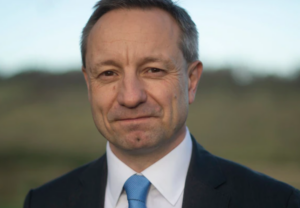The Office of Gas and Electricity Markets (Ofgem), which was set up on November 1, 2000, is run by Jonathan Brearley as its CEO.
The graduate of Glasgow University and the University of Cambridge has a bachelor’s degree in mathematics and physics and a master’s degree in economics.

How much does the CEO, Jonathan Brearley, make?
Jonathan Brearley’s net worth could be anywhere from £1 million to £5 million. As CEO of the Office of Gas and Electricity Markets (Ofgem), he gets paid £300,000 a year.
Brearley’s salary also seems to have gone up to £15,000 because of the recent rise in energy costs, but he hasn’t said much about how much he makes.
In 2020-2021, the Government office had an operating income of £109.1 million. Their main source of income is license fees paid by the sector. The license fee paid by the sector in 2020-2021 has a surplus of £0.7 million.
Also, Ofgem spent £20.9 million, and their staff costs went up by 20.8% from £100.3 million in 2019-2020 to £20.9 million in 2020-2021. So, it looks like they pay their workers enough to live a happy, comfortable life.
Wikipedia says that Jonathan Brearley is the CEO of Ofgem
Jonathan became the CEO of Ofgem on February 3, 2020. In 2018, he was named an executive member of GEMA, a position that will last until January 20,2025.
The CEO has a lot of experience in the energy sector, and as the director for Energy Markets and Networks at DECC, he was in charge of the Electricity Market Reform. In the same way, he was also in charge of the Office of Climate Change.
He was also a teacher at GEOS and a senior adviser in the Prime Minister’s Strategy Unit from 2002 to 2006. In the same way, his LinkedIn profile says that he also ran a consulting company.
Brearley also went to Glasgow University and got a Bachelor of Science in Mathematics and Physics. In the same way, he got his Master’s degree in Economics from the University of Cambridge.
Is Jonathan Brearley in a relationship?
Brearley seems to be married and settled down with his wife and children, but he hasn’t said anything about his relationship status.
The CEO has been very professional and has kept information about his personal life behind closed doors, so we don’t know who his significant other is or what they do.
So, we don’t know when Jonathan and his sweetheart got engaged and promised to spend the rest of their lives together. We don’t know much about their wedding, so we don’t know when they’ll celebrate their anniversary or how long they’ve been living together.
On the other hand, the CEO of Ofgem may have split up with his wife or girlfriend over the years and moved on with someone else. Since not much is known about his relationship status, people can only guess unless he opens up and talks about his life.

Who is the wife or partner of Jonathan Brearley?
Jonathan seems to have gotten married to Sumita, and the CEO’s two sons, Robin and Dilhan, were born to him and his wife.
But he hasn’t posted anything with his family on social networking sites. The CEO is so busy that he hasn’t even set up an official social networking account.
He is not on Instagram or Twitter. This may be because he has stayed away from social networking sites to stay safe. Or he could have decided not to waste his time scrolling through Facebook or Instagram.
So, there are no pictures of Brearley’s wife and kids on the internet. Hopefully, he will post some soon to keep his fans and well-wishers up to date on his life.
duties and rights
Most of the authority’s powers and duties come from laws, such as the Gas Act of 1986, the Electricity Act of 1989, the Utilities Act of 2000, the Competition Act of 1998, the Enterprise Act of 2002, the Energy Act of 2004, the Energy Act of 2008, and the Energy Act of 2010. The Gas Act spells out responsibilities and tasks related to gas, and the Electricity Act does the same for electricity.
Its main job is to protect the interests of consumers, and one way it does this is by making sure there is competition.
The main goal of the Authority is to protect the interests of current and future consumers when it comes to gas that moves through pipes and electricity that moves through distribution or transmission systems. The interests of consumers are their interests as a whole. This includes their interests in reducing greenhouse gases and making sure they have a steady supply of gas and electricity. Since 2010, the Authority has fined and taxed energy suppliers nearly £100 million. For example, in May 2014, E.ON had to pay a £12 million redress levy and British Gas had to pay a £1 million redress levy.
Structure
The chairman, Martin Cave, and both executive and non-executive members run the Gas and Electricity Markets Authority.
Jonathan Brearley will take over as Ofgem’s CEO in February 2020.
Competition in the UK market has grown.
Ofgas and OFFER come from the past.
In the 1980s, Margaret Thatcher’s government was the first to open up and privatize the energy markets in the UK (often called the Thatcher-Lawson agenda, due to the key role of Nigel Lawson in the Thatcher government cabinet). Some parts of the UK’s model have been put into EU law.
The Gas Act of 1986 and the Electricity Act of 1989 made it possible to privatize the gas and electricity industries. Section 1 of each Act created the jobs of the Director General of Gas Supply and the Office of Gas Supply (Ofgas), and the Director General of Electricity Supply and the Office of Electricity Regulation (OFFER). These regulators were not part of the government, but they had to answer to Parliament. This arrangement kept their regulatory decisions from being controlled by politics. This was done to give them more long-term regulatory certainty and to make it easier for people to get into the market and invest. Section 4 of the Gas Act of 1986 and Section 3 of the Electricity Act of 1989 said what the regulators had to do.
In the UK, electricity and gas for retail customers were separated from the rest of the industry in the 1990s. At the time of privatization, British Gas and the regional public electricity suppliers were the only ones who could sell gas and electricity to homes. In 1997, British Gas was split into Centrica and BG plc so that gas supply could be kept separate from gas production and delivery. Between 1996 and 1999, people who used energy at home got more and more freedom to choose their energy provider. In the end, the domestic gas market was fully opened to competition in May 1998. In May 1999, the domestic electricity market was also fully opened to competition.
What Ofgem Does
Before there was competition on domestic markets, regulators set price controls that limited how much monopoly suppliers could charge domestic customers. When the markets started to open up, these controls stayed in place. They were taken away in stages between 2000 and 2002. Ofgem decided to get rid of price controls because they thought competition was growing well at the time and that the Competition Act 1998, which has been in place since March 2000, would stop companies from abusing their market power and give Ofgem enough power to stop any abuse that did happen. Consumer surveys also showed that people knew they could switch, that the rate of switching away from the companies that used to have a monopoly was high and rising, and that their market shares were falling significantly and continuing to do so.
In April 2004, two years after the last price controls were lifted, Ofgem published a major review of the state of competition in the domestic energy supply markets. The review found that competition in the energy supply market had helped all consumers and that the markets were competitive, but not yet fully developed. Between 2005 and 2007, Ofgem did a Supply Licence Review, which led to the simplification of supply licenses. This was done to make it easier for new companies to get into the supply market and to make room for new ideas. In 2006, the Energy Supply Ombudsman had to be set up and paid for by the industry. This was because Ofgem was worried about how customer complaints were being handled.
Ofgem’s Energy Supply Probe, which was released in 2008 after rising world fuel prices caused the average household’s energy bill to double, found that the market was still dominated by the “Big Six” suppliers: more than 70% of customers were still with their former monopoly suppliers, and new entrants had only gotten 0.3% of the market. Ofgem took a number of steps that made it easier for customers to switch suppliers and gave customers better information. The Big Six had to keep separate books for their supply and generation businesses, and Ofgem was worried about unfair pricing and market abuse.
CMA probe, 2014–2016
In June 2014, Ofgem announced that the Competition and Markets Authority (CMA) would look into how the “Big Six” energy companies (Centrica, SSE plc, RWE npower, E.ON, Scottish Power, and EDF Energy) trade and how competitive they are. The competition regulator did the investigation, which took two years, after Ofgem asked them to. “Almost everyone agrees that a referral should be made, and the CMA investigation is a great chance to clear the air. This will help restore consumers’ trust in the energy market and give investors the certainty they have been asking for “The investigation was announced by Dermot Nolan, who is the CEO of Ofgem. In August 2016, Ofgem said it would follow the CMA’s suggestion that customers who have been on expensive tariffs for three years or more should have to give their information to rival suppliers. Ofgem also said that customers with pre-payment meters would have an interim price cap put on them.